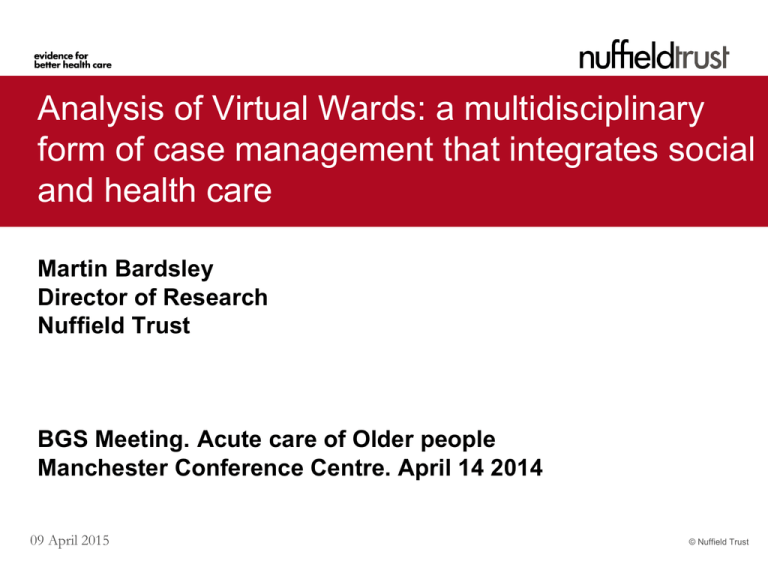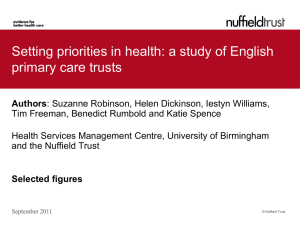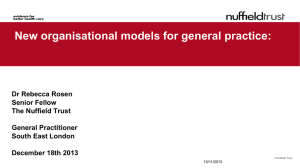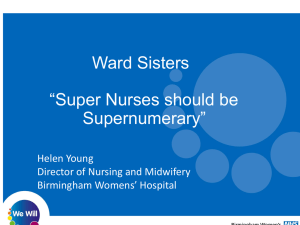
Analysis of Virtual Wards: a multidisciplinary
form of case management that integrates social
and health care
Martin Bardsley
Director of Research
Nuffield Trust
BGS Meeting. Acute care of Older people
Manchester Conference Centre. April 14 2014
09 April 2015
© Nuffield Trust
Background
09 April 2015
© Nuffield Trust
National Institute for Health Research (NIHR) report
© Nuffield Trust
0.00
No ACS diagnosis
ACS primary diagnosis
ACS secondary diagnosis
© Nuffield Trust
2010/11 Q4
2010/11 Q3
2010/11 Q2
2010/11 Q1
2009/10 Q4
2009/10 Q3
2009/10 Q2
1.00
2009/10 Q1
1.20
2008/09 Q4
2008/09 Q3
2008/09 Q2
2008/09 Q1
2007/08 Q4
2007/08 Q3
2007/08 Q2
2007/08 Q1
2006/07 Q4
2006/07 Q3
2006/07 Q2
2006/07 Q1
2005/06 Q4
2005/06 Q3
2005/06 Q2
2005/06 Q1
2004/05 Q4
2004/05 Q3
2004/05 Q2
2004/05 Q1
2003/04 Q4
2003/04 Q3
2003/04 Q2
2003/04 Q1
2002/03 Q4
2002/03 Q3
2002/03 Q2
2002/03 Q1
2001/02 Q4
2001/02 Q3
2001/02 Q2
2001/02 Q1
Number of emergency admissions
(millions)
10-year trend in emergency admissions (46 million admits)
1.40
+35% (40%)
+34%
0.80
0.60
0.40
0.20
Interventions to reduce avoidable admissions
Primary Care
ED Depts
Hospital
Transition
Practice features
Assess/obs wards
Structured
Discharge
Transition care
management
Medication review
GPs in A&E
Medication
Review
Rehabilitation
Case
management
Senior Clinician
Review
Specialist Clinics
Self management
and education
Telemedicine
Coordination end
of life care
Hospital at home
Virtual Wards
From Sarah Purdy 2013
© Nuffield Trust
Rationale for the virtual ward
Need to respond to growing needs of people with chronic health problems.
Emergency admissions have been rising for some time – undesirable for
patients and costly in terms of acute hospital care. No one explanation for
rise in emergency admissions – part patients factors, part health
systems.
Aim to develop approaches that are preventive before crises emerge.
Needed to identify patients at risk of future admissions.
Needed a linked process for managing high risk patients in community
settings.
Not clear what works see Purdy et al (2012) Interventions to Reduce Unplanned Hospital Admission:
A series of systematic reviews. Bristol University Final Report)
Average number of
emergency bed days
To prevent, we need to predict who will high costs in who in
the future
Predictive
models try to
identify
people here
…not the people
who are current
intensive users
© Nuffield Trust
Predictive modelling in the UK
Patterns in routine data identify highrisk people next year.
Use pseudonymous, person-level
data.
Relies on exploiting existing
information:
+ve: systematic; not costly data
collections; fit into existing systems;
applied at population level
-ve: information collected may not be
predictive; data lags
© Nuffield Trust
Describing a model’s performance
At the start of the year, no
one knows who’s who
A predictive risk
model tries to
sort it out
© Nuffield Trust
Predictive modelling is only as effective as the intervention it
is used to trigger
Top 0.5%
0.5 – 5.0%
6 - 20%
21 –
100%
Case Management
Intensive Disease Management
Less Intensive Disease
Management
Wellness Programmes
Need to link the risk strata to the treatment/management options
© Nuffield Trust
Virtual Wards =
Predictive Model
+
Hospital-at-Home
© Nuffield Trust
GP Practice 1
Virtual Ward A
GP Practice 2
GP Practice 3
Community Matron
Nursing complement
Health Visitor
Ward Clerk
Pharmacist
Social Worker
Physiotherapist
Occupational Therapist
Mental Health Link
Voluntary Sector Link
Original Croydon
Model for Virtual
Wards
Specialist Staff
•Specialist nurses
•Asthma
•Continence
•Heart Failure
GP Practice 4
•Palliative care team
GP Practice 5
GP Practice 6
GP Practice 7
GP Practice 8
Virtual Ward B
Community Matron
Nursing complement
Health Visitor
Ward Clerk
Pharmacist
Social Worker
Physiotherapist
Occupational Therapist
Mental Health Link
Voluntary Sector Link
•Alcohol service
•Dietician
Lewis* described the following model of care known as 'virtual wards‘
(1 of 2)
• Each virtual ward is linked to a specific group of GP practices (so pop
c.30,000)
• A patient is offered "admission" to a virtual ward if a risk prediction tool
identifies him or her as being at high risk of a future emergency hospital
admission.
• Patients remain in the community and receive multidisciplinary in person at the
patient's home, by telephone and/or at a local clinic.
• Each virtual ward has a capacity for 100 patients, i.e. 100 “virtual beds” per
virtual ward. These are subdivided into five "daily" beds, 35 "weekly" beds and
60 "monthly" beds, reflecting the frequency with which different patients are
reviewed on a ward round.
• Virtual ward staff can move patients between different “beds" as the patients'
needs change.
*Lewis GH. Case study: virtual wards at Croydon Primary Care Trust. London: King’s Fund; 2006. Available from:
http://www.kingsfund.org.uk/search_clicks.rm?id=6746&destinationtype=2&instanceid=349684
© Nuffield Trust
Lewis* described the following model of care known as 'virtual wards‘
(2 of 2)
• Virtual ward staff discuss patients on office-based "ward rounds", participating
either in person or by telephone.
• Certain specialist staff (e.g. tissue viability nurse) may cover several virtual
wards.
• The virtual ward staff share a common medical record.
• Systems to alert local hospitals, emergency departments and out-of-hours
providers that a patient is on a virtual ward.
• When a patient has been assessed by all relevant virtual ward staff, and has
been cared for uneventfully for several months in the ‘monthly review’ section of
the ward, then the ward staff may feel that the patient is ready to be discharged
back to the care of the GP practice.
*Lewis GH. Case study: virtual wards at Croydon Primary Care Trust. London: King’s Fund; 2006. Available from:
http://www.kingsfund.org.uk/search_clicks.rm?id=6746&destinationtype=2&instanceid=349684
© Nuffield Trust
Adaptations and evaluations
Site
Feature
Evaluation
Croydon
Nurse-led
NIHR funded study
Wandsworth
VWGPs
NIHR funded study
Devon
Practice-based
NIHR funded study
New York
Homeless
RCT
Toronto
Discharge Virtual Ward
RCT
North Somerset
Clinical referrals
Local study
Plus increasing number of different models in UK and abroad
See also Chenore T, Pereira Gray DJ, Forrer J, Wright C., Evans PH, Emergency hospital admissions for the
elderly: insights from the Devon Predictive Model J Public Health (2013)
© Nuffield Trust
Outline of three schemes
Croydon
Devon
Wandsworth
Date first virtual ward
opened
Number of virtual
wards under study
Funding
May 2006
October 2008
March 2009
2 then 8
1
4
Croydon PCT
NHS Devon and Devon County
Council
Wandsworth PCT and
Wandsworth Council
Model
Nursing led
GP practice led
GP led
Full-time staff
Community matrons and ward
clerks
Community matron and ward clerk
Community matron, virtual ward
GP, and ward clerk
Social workers, community
psychiatric nurse (CPN), CPN for
older people, staff grade elderly
care doctor, physiotherapist,
occupational therapist, voluntary
sector representative, district
nurses, GP, complex care team
manager (joint health & social care
appointment)
Social worker, district nurse,
physical therapist, occupational
therapist, pharmacist, drug &
alcohol therapist.
Number of part-time
Initial “pilot” virtual wards
project: pharmacist,
staff (wider
multidisciplinary team) physiotherapist, occupational
therapist, district nurses, health
visitor for older people,
representative of Croydon
Voluntary Action
After the initial pilot phase:
none
© Nuffield Trust
Evaluation methods
09 April 2015
© Nuffield Trust
Evaluation Methods
Three pilots sites with different models of virtual ward
Retrospective analysis of existing projects
Track cohort of specific patients to look at service use over time
Exploit existing data through secure data linkage
Compare change to matched control group (matched on multiple
variable using propensity and prognostic score)
Costing service activity and interventions
© Nuffield Trust
Information flows
From: Predictive Models for Health and Social Care: A Feasibility Study
© Nuffield Trust
Health and social care timeline – an individual’s history
© Nuffield Trust
Matching health diagnoses categories in intervention and
control groups
© Nuffield Trust
Example: Marie Curie Home Nursing Service.
Comparing hospital admissions for retrospectively matched controls
© Nuffield Trust
Findings
09 April 2015
© Nuffield Trust
Lengths of stay on the virtual wards
© Nuffield Trust
Costs of service use in the six months before starting on the
virtual ward according to risk band
£7,000
A&E
Community
Elective
Emergency
GP
Out Patients
£6,000
£5,000
Social Care
Cost Per patient
£4,000
£3,000
£2,000
£1,000
£0
1
-£1,000
2
3
4
5
6
7
8
9
10
Risk Strata
© Nuffield Trust
Virtual ward patients
The virtual ward patients in one site had
•
a mean combined model score of 0.63 compared with score of 0.06 for the rest of the
population.
•
a higher rate of emergency hospital admissions (2.64 per patient compared with 0.06).
•
more general practice surgery visits (42.99 visits compared with 5.55).
•
more contact with community nurses (68.6 per cent of virtual ward patients had been in
contact with community nurses in the year before receiving the intervention compared
with 1.0 per cent for the rest of the population).
•
more chronic health problems 2.48 vs 0.07 conditions for the rest of the population.
•
more social care services eg 19.3 per cent of virtual ward patients had received home
care at some point in the previous twelve months, compared with 0.5 per cent for the
rest of the population.
© Nuffield Trust
Changes in observed costs
Individual service use costs on the six months before and
after starting the intervention (n=989)
% with a cost
(pre or post)
Total Cost
Pre(£000s)
Avg Cost pp
pre(£)
% Total (pre)
Avg Cost pp
Post (£)
% total Cost
Posts
GP
92%
135
501
8.0%
538
9.0%
Community
62%
396
401
6.4%
837
14.0%
A&E
60%
748
136
2.2%
100
1.7%
Elective
26%
2,407
757
12.0%
504
8.4%
Emergency
55%
496
2,433
38.8%
1,867
31.1%
Out Patients
78%
555
561
8.9%
437
7.3%
Social Care
32%
1,473
1,489
23.7%
1,714
28.6%
6,210
6,279
100.0%
5,996
100.0%
Total
© Nuffield Trust
Matching process to create ‘controls’
Intervention
patients (n=1,231)
Mean age in years (SD)
Female
Mean socioeconomic
score (SD) *
Mean number of
chronic conditions (SD)
Mean predictive risk
(SD)
Angina
Asthma
Cancer
Cerebrovascular
disease
Congestive heart
failure
COPD
Diabetes
History of falls
History of injury
Potential controls
Matched controls
71.23 (16.86)
54.8
(n=2,083,830)
39.83 (23.32)
55.1
(n=1,231)
71.61 (17.45)
55.6
Matching based on:
24.06 (10.88)
24.58 (11.91)
25.51 (10.90)
Age, sex, ethnicity, IMD
2.70 (1.66)
0.21 (0.66)
2.46 (1.58)
0.60 (0.25)
0.08 (0.09)
0.57 (0.24)
23.2
20.6
15.5
1.5
2.8
2.7
21.4
19.6
12.5
19.8
1.1
19.0
22.7
0.8
17.2
23.2
29.7
24.5
44.6
0.9
2.8
2.2
6.9
18.5
28.5
25.9
45.7
Recorded diagnoses
Prior use
Predictive risk score
© Nuffield Trust
Patterns of hospital costs (pre/post)
© Nuffield Trust
Changes in hospital activity
© Nuffield Trust
Observations on impact on care use
Sample dominated by one site
Difficulties in matching to patients with complex health problems
(had to use national hospital based models)
No evidence of reductions in emergency admissions at six months
Indications of possible reductions in OP and elective care
© Nuffield Trust
Reality of implementation
In largest site the model ‘changed’
•
from multidisciplinary case management to standard service delivered by a
community matron supported by an administrative assistant
•
Predictive model not used consistently throughout
•
organisational commitment and investment in preventive care for high risk patients
but local GPs seemed less visible
•
Long lengths of stay linked with incentives to have 500 patients on virtual wards.
Large differences between sites in costs of virtual wards itself
Two sites still in early stages - and have subsequently developed
© Nuffield Trust
Impact of eight different interventions on hospital use
© Nuffield Trust
Cautions in evaluation……
1. Recognise that planning and implementing large scale service
changes take time
2. Define the service intervention clearly – and be clear when the model
is changed
3. If you want to demonstrate statistically significant change, size and
time matter
4. Hospital use and costs are not the only impact measures
5. Carefully consider the best models for evaluation –
prospective/retrospective; formative/summative; quant./qualitative
© Nuffield Trust
General observations
There were different 'forms' of virtual ward in this study and we suspect an even wider
number of variants in other settings.
Our analyses have shown how patients being cared for on virtual wards included some
people with serious complex illnesses that have important health service implications.
Virtual wards are part of a generic approach to long term care which may be justified in
other terms, for example as ways to improve the quality of communication between
community health staff, the continuity of care, patient experience or safety. No simple
solutions we can take off the shelf
Though the evidence was not conclusive, the differential levels of service use in high risk
patients suggested that these would provide more fertile ground for interventions aimed at
reducing hospital use.
© Nuffield Trust
Acknowledgements
This work was funded by the National Institute for Health Research
(NIHR) Service Delivery and Organisation (SDO) programme. Project
number 09/1816/1021.
The views and opinions expressed here are those of the authors and do
not necessarily reflect those of the NIHR SDO programme or the
Department of Health.
We are grateful to the support and guidance of staff in our three study
sites, and in particular our site representatives:
• Paul Lovell (Devon)
• David Osborne (Croydon)
• Seth Rankin (Wandsworth)
© Nuffield Trust
www.nuffieldtrust.org.uk
Sign-up for our newsletter
www.nuffieldtrust.org.uk/newsletter/login.aspx
Follow us on Twitter
(http://twitter.com/NuffieldTrust)
martin.bardsley@nuffieldtrust.org.uk
09 April 2015
© Nuffield Trust








